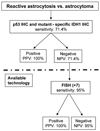A sensitive and specific diagnostic panel to distinguish diffuse astrocytoma from astrocytosis: chromosome 7 gain with mutant isocitrate dehydrogenase 1 and p53
- PMID: 21343879
- PMCID: PMC3061457
- DOI: 10.1097/NEN.0b013e31820565f9
A sensitive and specific diagnostic panel to distinguish diffuse astrocytoma from astrocytosis: chromosome 7 gain with mutant isocitrate dehydrogenase 1 and p53
Abstract
One of the major challenges of surgical neuropathology is the distinction of diffuse astrocytoma (World Health Organization grade II) from astrocytosis. The most commonly used ancillary tool to solve this problem is p53 immunohistochemistry (IHC), but this is neither sensitive nor specific. Isocitrate dehydrogenase 1 (IDH1) mutations arecommon in lower-grade gliomas, with most causing a specific amino acid change (R132H) that can be detected with a monoclonal antibody. IDH2 mutations are rare, but they also occur in gliomas. In addition, gains of chromosome 7 are common in gliomas. In this study, we assessed the status of p53, IDH1/2, and chromosome 7 to determine the most useful panel to distinguish astrocytoma from astrocytosis. We studied biopsy specimens from 21 World Health Organization grade II diffuse astrocytomas and 20 reactive conditions. The single most sensitive test to identify astrocytoma is fluorescence in situ hybridization for chromosome 7 gain (76.2%). The combination of p53 and mutant IDH1 IHC provides a higher sensitivity (71.4%) than either test alone (47.8%); this combination offers a practical initial approach for the surgical pathologist. The best overall sensitivity (95%) is achieved when fluorescence in situ hybridization for chromosome 7 gain is added to the p53-mutant IDH1 IHC panel.
Figures


References
-
- Colodner KJ, Montana RA, Anthony DC, et al. Proliferative potential of human astrocytes. J Neuropathol Exp Neurol. 2005;64:163–169. - PubMed
-
- Burger PC, Shibata T, Kleihues P. The use of the monoclonal antibody Ki-67 in the identification of proliferating cells: Application to surgical neuropathology. Am J Surg Pathol. 1986;10:611–617. - PubMed
-
- Deckert M, Reifenberger G, Wechsler W. Determination of the proliferative potential of human brain tumors using the monoclonal antibody Ki-67. J Cancer Res Clin Oncol. 1989;115:179–188. - PubMed
-
- Louis DN. The p53 gene and protein in human brain tumors. J Neuropathol Exp Neurol. 1994;53:11–21. - PubMed
-
- Okamoto Y, Di Patre PL, Burkhard C, et al. Population-based study on incidence, survival rates, and genetic alterations of low-grade diffuse astrocytomas and oligodendrogliomas. Acta Neuropathol. 2004;108:49–56. - PubMed
Publication types
MeSH terms
Substances
Grants and funding
LinkOut - more resources
Full Text Sources
Medical
Research Materials
Miscellaneous

